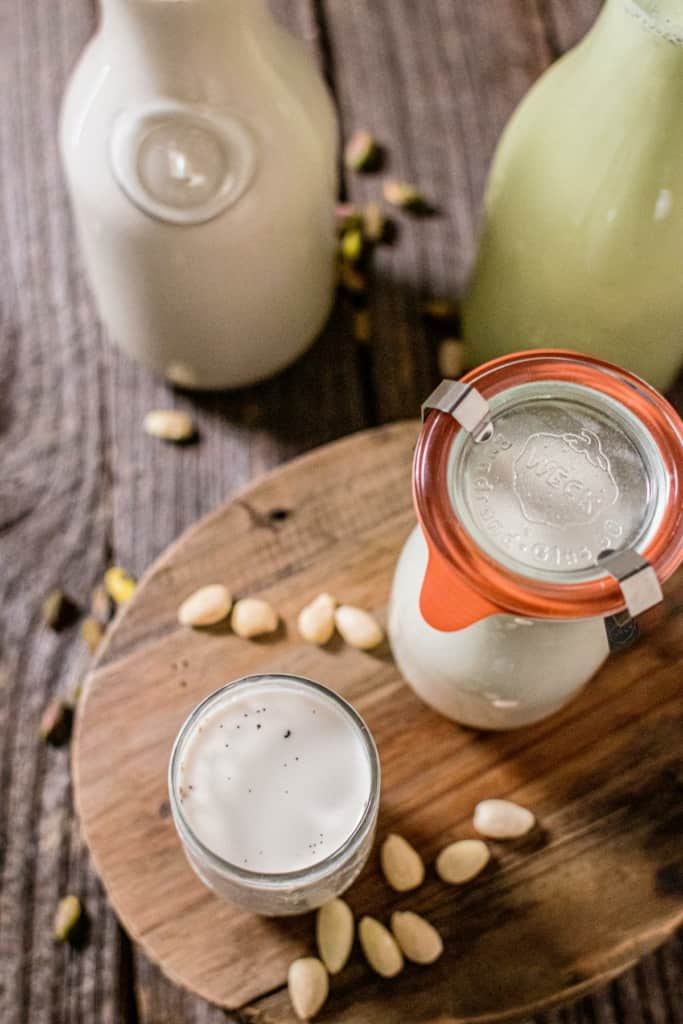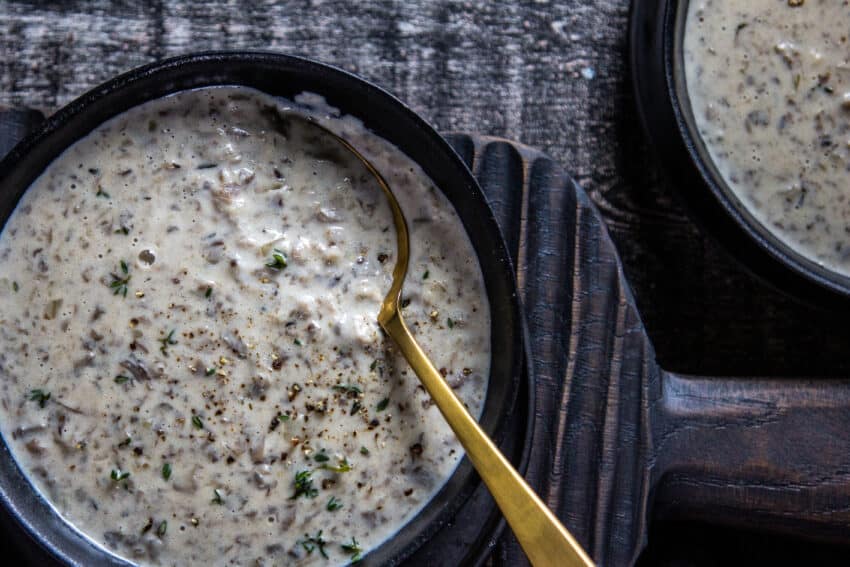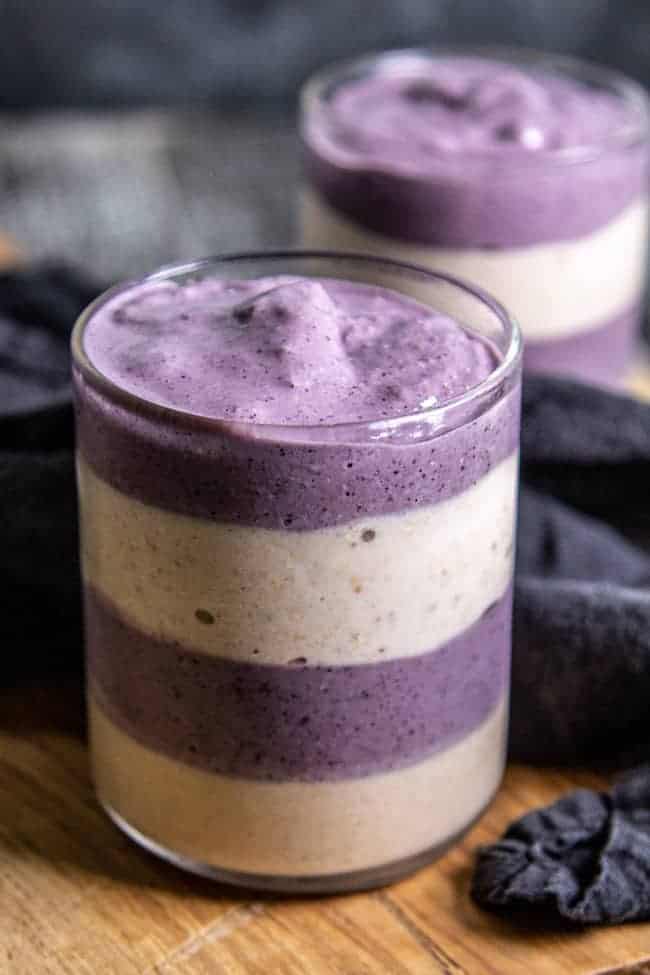Almond milk is a popular plant-based substitute for dairy milk. It’s dairy-free, but is it also gluten-free? Here’s everything you need to know.
How is almond milk made?
The commercial almond milk process begins by blending almonds and water together to create a pulp. The pulp then goes through a process of straining and dilution. Finally, the almond milk is pasteurized and homogenized to extend shelf-life.
Does commercial almond milk contain additives?
Go ahead and grab a carton of your favorite store-bought almond milk. You might assume that the ingredients simply read “almonds and water” - but that’s not likely the case. Commercial almond milk often contains added vitamins, stabilizers (usually called “gums”), and added flavors.

Why are vitamins added to almond milk?
Most folks choose almond milk as an alternative to dairy milk. Dairy milk is much higher in certain vitamins and minerals, so many manufacturers add in extra nutrients to ensure almond milk has a similar nutritional profile to dairy milk.
Why are gums added to almond milk?
Adding ingredients like guar gum, gellan gum and locust bean gum serve to stabilize the almond milk. In layperson’s terms, these gums keep the solids suspended in the liquid and prevent sediment from sinking to the bottom.
Why are natural flavors added to almond milk (and what the heck are they)?
Many brands add “natural flavors” to their almond milk to enhance flavor. The FDA defines natural flavors as anything derived from a “natural” product - think spices, fruit, yeast, vegetables, etc. The origins may be natural, but these flavors are often “enhanced” or processed before addition to the almond milk.
There are no requirements for manufacturers to disclose the exact ingredients used in their natural flavors. However, they are required to state if any common allergens, including wheat, are present.

Is almond milk gluten-free?
Gluten is a protein naturally occurring in certain grains like wheat, barley and rye. Most major brands of almond milk are gluten-free. Nonetheless, scanning the label is still important - especially if you’re opting for flavored varieties. If wheat is present in any of the additives or flavorings, manufacturers must state this on the label.
What does almond milk taste like?
Descriptions of unflavored (or unsweetened) almond milk often include things like subtly sweet, slightly nutty and creamy. While some people claim it tastes like dairy milk, that’s not our opinion. Both have a pleasant - but distinctly different - flavor.
How to use almond milk
Almond milk uses include enjoying it with your morning bowl of cereal, in smoothies, in your morning coffee, or simply as a refreshing beverage.

Can you substitute almond milk for whole milk in recipes?
Almond milk works as a plant-based alternative to dairy milk in most recipes. We recommend sticking with unflavored almond milk - flavored varieties are often sweetened and will affect the ultimate flavor of your recipe.
Can you use almond milk to make sauces and soups?
Almond milk thickens when heated, so you can use almond milk to make dairy-free versions of your favorite sauces and soups.
Can you use almond milk in place of dairy milk when baking?
Almond milk has more water and less protein than dairy milk, so you may notice some subtle differences in the recipe. Protein helps to create beautifully browned, fluffy confections with a delicate crumb. Whole dairy milk has about 8 grams of protein per cup, while almond milk clocks in at only one gram. Our friends at Food Network suggest swapping soy milk for dairy milk instead - it has more protein and a similar subtle flavor.
How to make homemade almond milk
Making your own almond milk at home is easier than you think! Here’s how to do it.
- Soak 1 cup of almonds in water for 12-36 hours. Drain and rinse.
- Blend with 2 cups of water until smooth.
- Strain the mixture through a cheesecloth and squeeze thoroughly. If you prefer almond cream, you’re all finished. Otherwise, proceed to the next step.
- Add another cup of water and whisk to combine.
- Add any desired flavors or sweeteners.
Healthier ways to sweeten almond milk
Our friends at California Grown add prunes before blending the soaked almonds and water together. The prunes add a lovely caramel sweetness to the homemade almond milk. You can also use dates if you prefer. Honey, vanilla or cocoa also add fabulous flavor to your homemade almond milk.
Gluten & dairy-free recipes using almond milk

Snickerdoodle Cake
Snickerdoodle cookies are pure heaven - but this cake might be even more delicious. You’ll never believe that this Snickerdoodle Cake is gluten and dairy-free.
Cream of Mushroom Soup
Let’s be honest here - canned cream of mushroom might be fine in casseroles, but you certainly don’t want to slurp up a whole bowl of it. That’s not the case with this velvety, made-from-scratch recipe. Use almond milk to whip up a plant-based version of this homemade Cream of Mushroom Soup!


Chocolate Martini
It’s five o’clock somewhere. This creamy Chocolate Martini is the dairy-free cocktail of your dreams!
Blueberry Banana Bread Layered Smoothie
Have you ever tried making a layered smoothie? They’re visually striking - and totally tantalizing. We love this vegan Blueberry Banana Bread Smoothie from This Mess is Ours.


Gingerbread Pear Muffins
Rich with warm spices and chunks of sweet pear, Alison’s Gingerbread Pear Muffins are the perfect morning treat.
Almond White Chocolate Horchata
Kate describes her Almond White Chocolate Horchata as “an easier, healthier milkshake”. Bonus: this delightful, dairy-free drink takes less than 5 minutes to make.

Photos of almond milk courtesy of California Grown.













Let Us Know What You Think